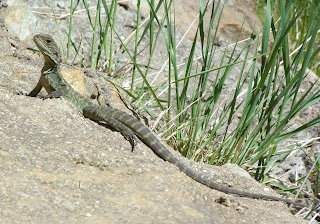ANPS translates Cubitum vulpei ...

... into Fox's Elbow (unlike the road sign makers who use - inter alia - Foxes Elbow or Foxe's Elbow). Enough with the Latin: there are too many photographs of lovely things. After this image of the basic habitat I'll begin with the orchids as I am sure the orchid experts will want to get stuck right in to the Diuris mystery starting at the second image down. Diuris sulphurea. This is the mystery and I have shown three images of it in the hope this will enable someone to say what it is. Hopefully without use of the cheaty word 'aff'. The overall colour was like D sulphurea but it was much smaller than all the other examples of that species and it didn't have the brown spots. This one was right at the end and referring to David Jones' big boo k I have concluded it is D. pedunculata , the Small Snake Orchid. The location today was not far from Braidwood specifically mentioned as part of the range. Thelymitra pauciflora ...



